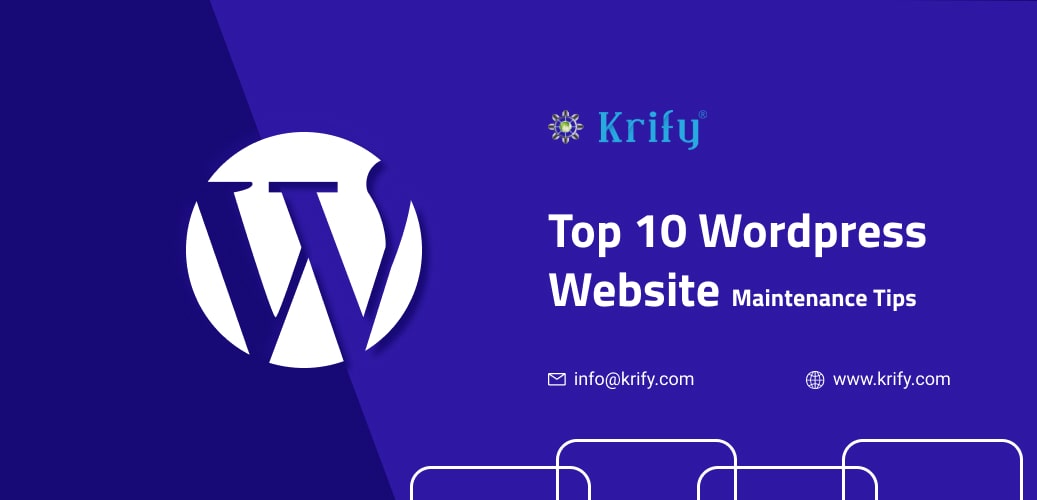WordPress is one of the most popular content management systems available today. It is used by individuals and small-to-large companies alike to power their websites, blogs, and eCommerce sites with ease. To keep your WordPress site up and running smoothly, you have to follow these WordPress Website Maintenance Tips and regularly perform tips to ensure that your site stays fast and secure at all times.
Most small-scale businesses and large-scale businesses will, at some point in time, need to take care of their WordPress website. It is important to know what types of things should be done regularly for optimal security and performance. Below are some WordPress Website Maintenance Tips that can help ensure your website stays up-to-date with the latest security patches and doesn’t slow down over time.
WordPress Website Maintenance Tips
Content:
- Perform Regular Backups
- Keep WordPress Theme, Plugins Up to Date
- Often Optimize the Database
- Fix the Broken Links
- Test WordPress Website Contact Forms
- Check and Optimize WordPress Website Mobile Friendly
- Monitor User Activity
- Delete Unused WordPress Themes
- Regularly Optimize WordPress Website
- Secure WordPress Website
-
Perform regular backups
This may seem unimportant to some webmasters until something goes wrong in their lives. WordPress backups are like spare tires; we don’t know when we’ll need them, but we know they’ll come through for us if anything goes wrong. For any reason, your site’s material may be lost. It might be the result of a cybercrime attack, an update gone wrong, or malware infection. Whatever it is, putting things back the way they were isn’t pleasant work. If you don’t already have one, create one now. It will allow you to restore your website to its previous position should something go wrong.
-
Keep your WordPress Theme, Plug-in up to date:
Another aspect to remember when maintaining your WordPress site is to keep it up to date. Just like any other program, WordPress has upgrades on a regular basis, and they aren’t only done for the sake of it. However, millions of WordPress websites continue to run outdated versions of WordPress software. They’re probably concerned that the upgrade process will somehow fail. Also, be wary of themes and plugins from untrusted sources. Before installing a theme, look for honest opinions and ratings. Also, check if it’s popular among the WordPress community. You may also use antivirus software or an online virus scanner to check whether a plugin or theme is malware-free.
-
Often Optimize the Database:
The WordPress database is clear and well-organized when it is first installed. As the website expands in size, it becomes clumsier and may slow down your site. Because the WordPress database holds all of your posts, pages, comments, categories, users, tags, custom fields, and other WordPress settings, this is the case.
-
Fix the Broken Links:
Broken links are links that take you to a “404 error” page. They occur when you change the name or position of a website without updating your internal connections. You should check for and repair any broken links regularly. Broken links may harm your SEO efforts and put off your visitors.
-
Test WordPress Website Contact Forms:
WordPress form builders can assist you in producing attractive forms on your website. These forms, on the other hand, may become out of date. This might be caused by a misconfiguration on your WP hosting server or an issue with your email server.
-
Check and Optimize WordPress Website Mobile Friendly:
Check your site on mobile frequently to guarantee it is still loading quickly. Keep in mind that if your site does not load quickly, roughly half of your visitors will depart. Check to see if your site is easy to browse and displays effectively.
-
Monitor user Activity:
If you have many users using your blog, you’ll need to keep an eye on things. This is only possible if you have a WordPress user activity log that records all actions on your site. When a user makes a mistake that may damage your website, the user log identifies who made the change, when it occurred, and where it came from. All of this data is critical when trying to diagnose and repair any problems before they get out of hand.
-
Delete Unused WordPress Themes:
If you don’t need a theme or plugin, why keep it? It takes up room and can cause issues. As a result, determine what plugins and themes you’ll need and remove the rest. Remove any plugins or themes that aren’t being used. You may download them again if you ever require them. This is a simple procedure that will produce a quicker, more secure website.
-
Regularly Optimize WordPress Website:
Websites with a slow performance are the first thing a person notices. If it takes longer than 3 seconds to load, users become irritated and move on to the next website. As a result, to retain your visitors and improve your search engine position, make sure your site is fast. Google and other search engines pay more attention to websites that load rapidly rather than those that take a long time to load. To optimize for speed, here are 3 things to do:
– Enable Caching
The simplest approach to boost the performance of your website is to delete any components that are slowing it down. This is a method for avoiding data redundancy, which is when you download the same data over and over again.
– Optimize Images
The goal of image optimization is to reduce the file size of your images while still keeping them good enough for display. WordPress comes with several tools for optimizing images, including WP Smush, Optimole, Compress JPEG, and PNG.
– Enable Lazy Loading
Lazy loading can help to improve a website’s load speed when it first loads. It works like this: when a person visits your site, WordPress defers the loading of some elements until they are required (i.e., as you scroll down).
-
Secure WordPress Website:
WordPress, like any other program, can be hacked if effective security measures and procedures are not followed.
– Use a security plugin
When it comes to WordPress security, this is the simplest step to do. Install and enable a reliable security plugin, such as WordFence. A good security plugin is updated regularly and can also safeguard your site from infection.
– Use a Strong Password
Your password is analogous to a front door. The more powerful it is, the more difficult it will be for burglars to break in. Unfortunately, many WordPress users are unaware of this. Weak passwords are the cause of thousands of WordPress hacks.
– Enable Two-factor Authentication
2FA is a process that entails checking in to your website using your password and another method. A text message, a phone call, or a one-time password might also be used (OTP).
Conclusion
Krify is a website design and development firm with over ten years of experience. We can help you launch or update your business’s online presence, while also providing maintenance support to ensure it stays up-to-date and running smoothly. For more information, contact us.









